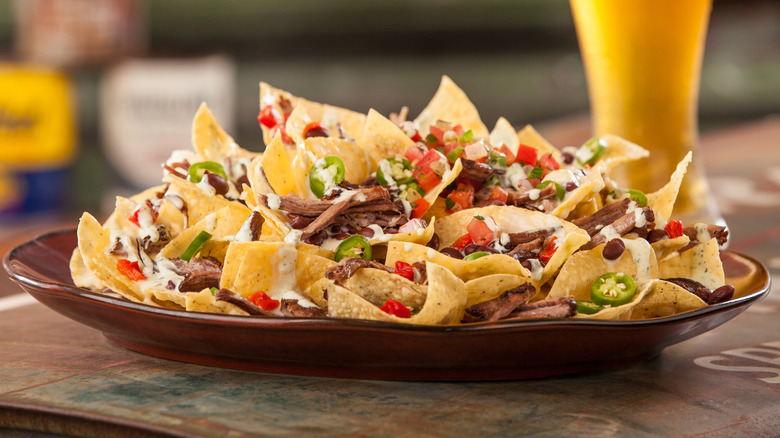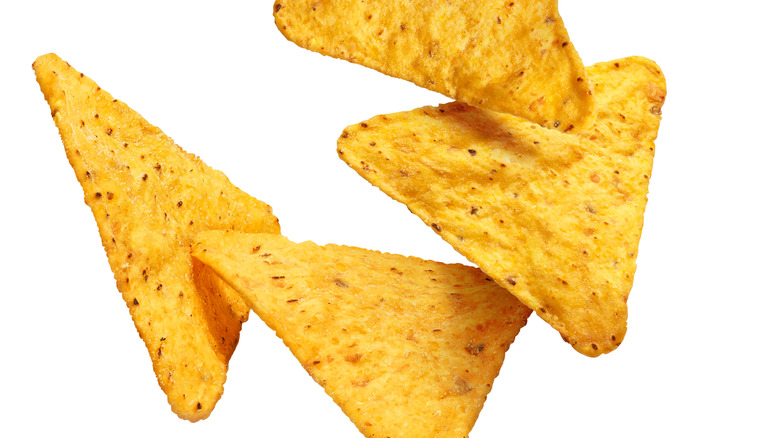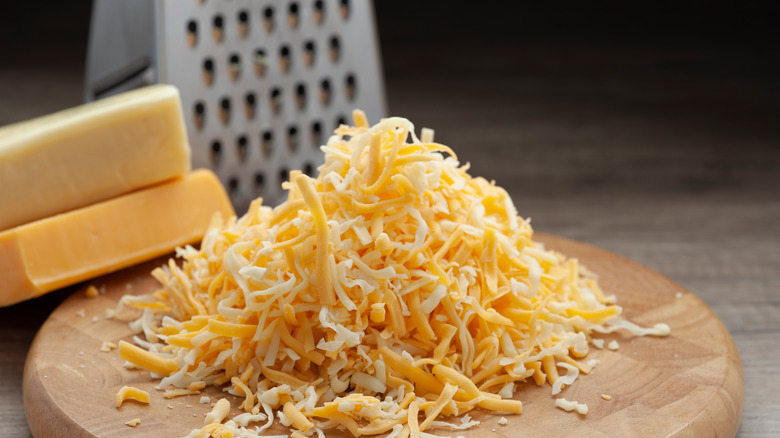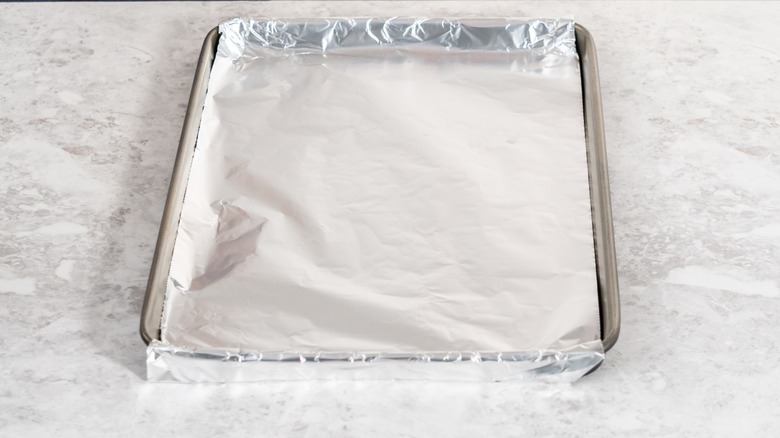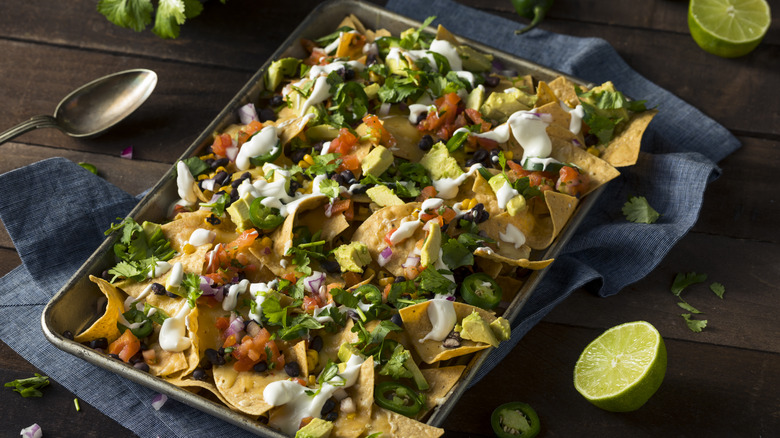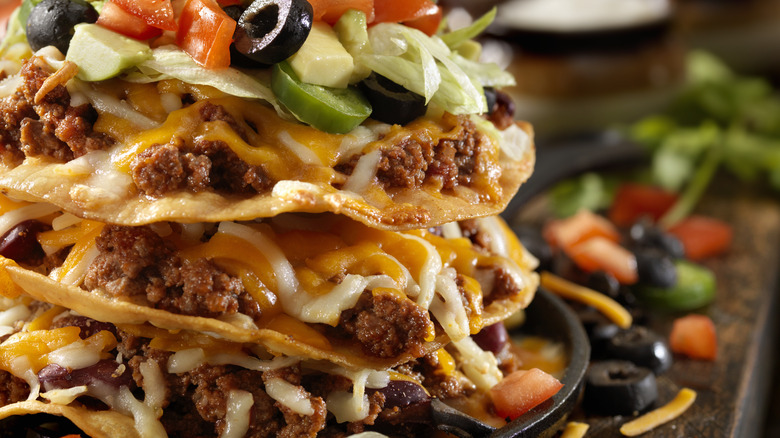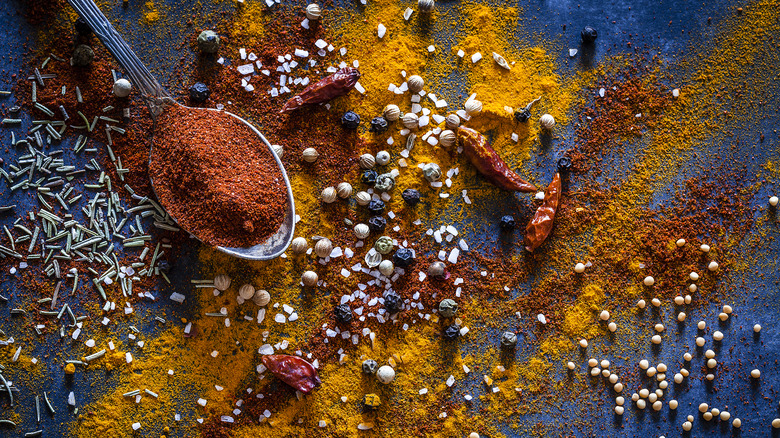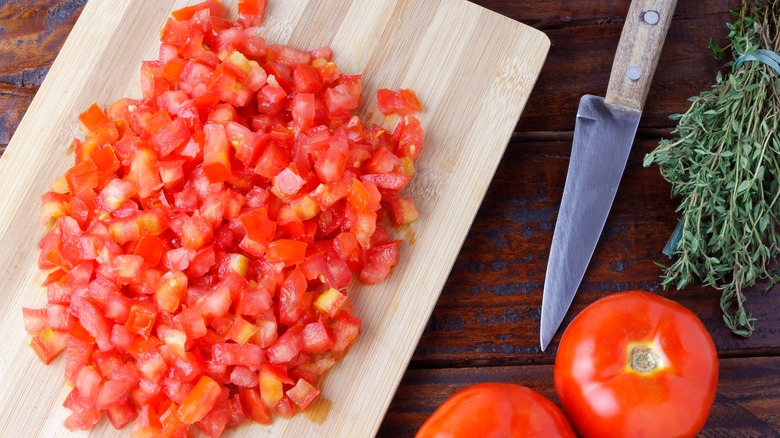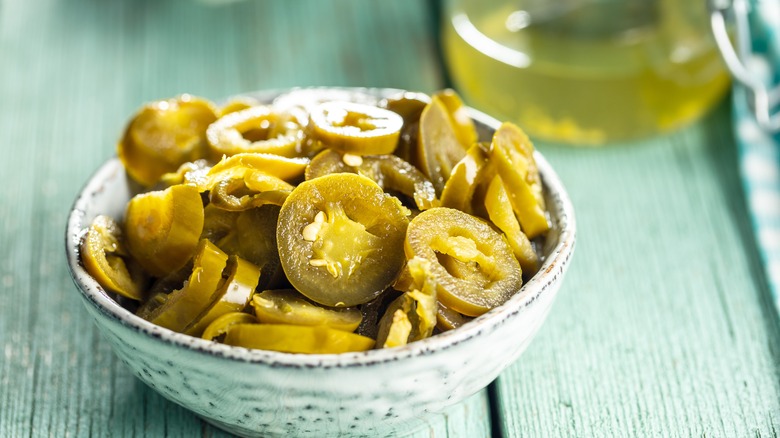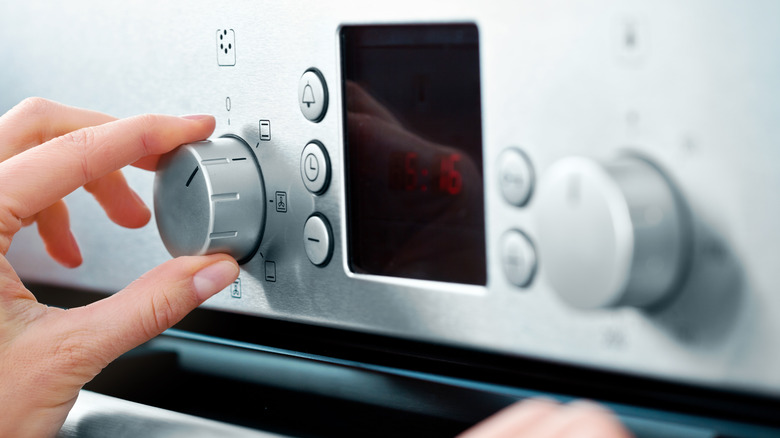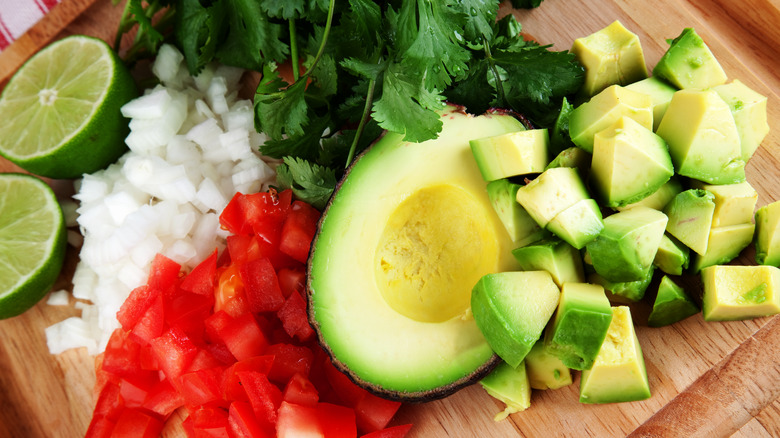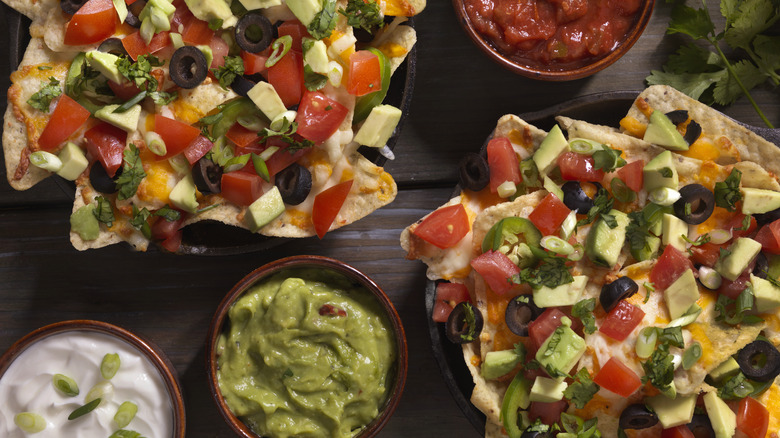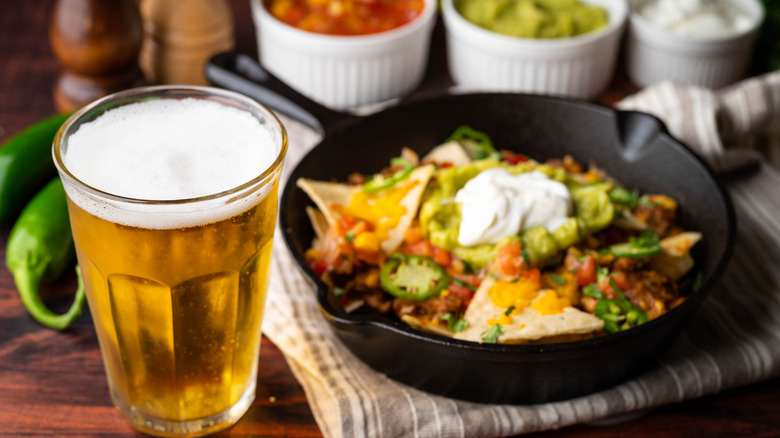12 Tips For Making The Best Nachos Every Time
What's not to love about nachos? The combination of crispy tortilla chips, savory proteins like pulled pork or beans, melty cheese, and fresh toppings like salsa and guacamole make a mouthwatering dig-right-in meal that's great for a crowd — or a party of one.
Nachos got their name from Ignacio Anaya, nicknamed Nacho, who worked at the Victory Club restaurant in Piedras Negras, a small Mexican city near the U.S. military base in Fort Duncan, Texas. One night at the restaurant in 1943, Anaya is said to have thrown together a dish of freshly fried tortilla chips, shredded cheese, and sliced jalapeños for some U.S. military wives hungry for something to eat after a day of shopping. The dish was a hit and grew in popularity throughout the southwestern United States before becoming the well-known food they are today.
A tray of nachos is the ultimate party and sports-watching food because they are quick to make, shareable, easy to customize for different tastes, and a great way to use up leftovers — not to mention irresistibly good. But, while you may not need to stress over exact measurements when making nachos, you do need a proper mix of toppings and a solid technique for perfectly constructed nachos that don't turn out soggy or bland. Read on for our most helpful tips so you can be confident in making the crispiest, tastiest nachos every time.
Choose the right chips — or fry your own
Thin tortilla chips may not scrape the roof of your mouth when you eat them, but for nachos, it's best to avoid them. These light, brittle chips just aren't sturdy enough to hold all the delicious toppings. Plus, thin tortilla chips will likely get soggy from the warm, wet toppings before they even reach your mouth. So opt for thicker, sturdier tortilla chips that can withstand the weight of cheese, beans, meat, and all the other goodies you want to pile on top of them.
And if you want to add some pizzazz to your nachos, throw in some colored tortilla chips in shades of blue and red. Another type of chip to consider? Nacho Cheese Doritos. Pre-seasoned with a blend of cheese and spices, these mouthwatering store-bought chips are the perfect thickness and make the best ultra-cheesy Texas-style nachos.
But if you really want to take things up a notch, spare a few minutes and fry a fresh batch of homemade tortilla chips. Cut a stack of soft tortillas (the kind you use for soft tacos) into triangles and fry them in hot oil until golden brown. Drain them on paper towels and season them with fine sea salt while still warm. Once you try homemade tortilla chips, you'll never care to eat store-bought ones again.
Use block cheese instead of pre-shredded cheese
The cheese you use can make or break your nachos, so listen up. Use block cheese instead of pre-shredded cheese for nachos. Why? Pre-shredded cheese dries out easily and contains anti-clumping preservatives like potato starch, preventing it from melting well and forming that wonderful gooeyness we crave in nachos. We recommend using small or medium holes on your box grater, as smaller pieces will melt faster and more evenly. There's nothing more sad than clumpy, half-melted cheese on nachos.
Certain cheeses aren't great for use in nachos, while others shine. It all comes down to taste, texture, and meltability. Avoid hard cheeses with high oil content, like Parmesan and Pecorino, which can separate when heated. And steer clear of pungent cheeses like blue cheese and feta, which can overshadow the other flavors. The best types of cheese for nachos are ones that melt well — and, of course, taste good to you. Stick to cheeses that become smooth when heated and have a medium flavor that won't overpower the nachos. Cheeses like Jack, cheddar, and mozzarella are popular for nachos. And in case you're wondering, there's absolutely nothing wrong with using cheese sauce on your nachos. Just please, make it from scratch.
Make cleanup easy by using aluminum foil
One-pan meals are the best. They're ideal for weeknights or large parties because they are simple to prepare, comforting to eat, and cleanup is a breeze. These no-fuss meals offer us the pleasure of home cooking without the dreaded chore of washing multiple dishes. These are just some of the reasons we love nachos, one of our favorite one-pan meals.
Using aluminum foil to bake your nachos is a no-brainer. It keeps your pan clean, so you don't have to worry about melty, sticky cheese falling onto it and burning — there's almost nothing more challenging to scrape off a pan than burnt cheese. So, before you begin constructing your nachos, tear off a large piece of aluminum foil and press it into a rimmed baking tray. Build the layers of nachos on top, bake, then serve. When the nachos are finished and the festivities are over, simply discard or recycle the foil. The aluminum foil keeps your baking pan from tarnishing and makes cleanup really easy, which is incredibly convenient when hosting a party.
Spread the nachos to avoid overcrowding
Overcrowding is a common cooking mistake. No matter what you're making, you should never crowd too many ingredients in the pan, on the grill, or wherever you're cooking. If you crowd your pan, the food will be exposed to inconsistent heat. This prolongs cooking time, leading to uneven cooking. In the case of nachos, this results in uneven browning of chips, unbalanced warming of toppings, and haphazard melting of cheese.
Our solution? Spread your nachos out with room to breathe. Regardless of the size of your batch, the best kitchen equipment for making nachos is a sheet pan or large cast-iron skillet. Give yourself more room than you think you'll need. If you don't use the whole pan or skillet, it won't be a problem. When you evenly spread your nacho ingredients onto a pan, you'll avoid having chips with burnt edges and improperly melted cheese. Plus, you'll lessen the chances of the nachos getting soggy, the one thing you definitely don't want your nachos to be.
Layer it
If you're a nacho newbie, you may think that making nachos is as simple as piling a mound of tortilla chips on a sheet pan and covering them with beans, shredded cheese, and cooked meat. While a towering mound may look pretty cool and eye-catching, nachos made this way are in no way fun to eat — especially after you consume the top layer of toppings and you're left with nothing but a pile of sad, bare chips scattered with scraps of toppings.
Instead, you should construct your nachos in layers. Begin by arranging a single layer of tortilla chips on a baking sheet, overlapping them slightly. Then, cover the chips with cheese and toppings. Repeat this layering with the remaining ingredients so every bite is the same — and avoid leaving any chips bare, as they're more likely to burn that way. Forming multiple layers ensures that each bite will have a proper mix of flavors and that each chip will be dressed with toppings. Turns out, the trick to making nachos is in the layers, and even just following this one simple tip will make your nachos way better.
Flavor your protein
A good rule of thumb when cooking is to season throughout the cooking process. Each time you incorporate an ingredient, you should season the food. This is because if you only season at the end of the cooking process, the spices will just sit on top. But, if you season as you go, you give the spices a chance to meld with all the ingredients and improve the dish's overall flavor. By sticking with this technique, you can be confident that every bite will be infused with flavor, not just the exterior. Your dish will taste well-balanced and flavor-packed throughout.
This season-as-you-go technique applies when making nachos, too. Every component of your nachos should stand well on its own, especially your protein. Layering unseasoned meats over chips or just pouring a can of black beans on top won't get the job done. Taking the time to cook black beans in spices like paprika and cumin will boost flavor and savoriness. When cooking meats for your nachos, you should season them like a standalone dish.
For maximum flavor, use spices like chili powder, garlic, and oregano to infuse plenty of flavor into the meat, or make your life easy and use packaged taco seasoning. You can also opt for smoked meats for convenience. Or, if you're fortunate to live near a Mexican market, you can likely find some marinated carne asada, spicy chorizo, or flavorful pre-cooked meats like carnitas and al pastor that work exceptionally well in nachos.
Chop your toppings into bite-sized pieces
Eating nachos is always messy — in fact, it's one of its most endearing qualities. But eating nachos shouldn't be difficult. So, make sure your toppings, like grilled chicken, tomatoes, and avocados, are cut into bite-sized pieces. Each component should be small enough to eat in one bite (or two). You want your toppings on the small side to keep the dish from being too hard to eat. Nachos are finger food, so please don't make your guests rely on knives and forks to eat them.
When cooking meat for your nachos, use a spatula to break up ground meat into small clumps while cooking. If using leftover meats like grilled steaks, cut them into small cubes before spreading them over your nachos. If using roasted chicken or pork shoulder, you should finely shred the meat before layering it between chips. When making plant-forward nachos, chop your vegetables into small pieces, including any plant proteins like tofu or seitan. If you stick to this tip and take the time to chop your toppings into bite-sized pieces, you'll keep your guests happy by keeping the dish from getting too hard to handle.
Add an acidic ingredient like pickled jalapeños
Any good cook knows that using an acid in cooking can elevate a dish from good to great. A simple act like adding lemon juice to grilled fish, pickles to a sandwich, or red wine vinegar to stews can add a pop of clean, bright notes and enhance the flavor of the other ingredients. You can brighten up any dish by adding a little acidity. Garnishing nachos with pickled foods adds a bright, vinegary tang that cuts through the dish's rich, fatty flavors.
Pickled jalapeños are the original (and, in our humble opinion, the best) acidic topping for nachos — and for good reason. Pickled jalapeños have a soft, chewy bite that pairs wonderfully with the crispy, gooey textures found in nachos. Further, the heat level of jalapeños is on the lower end of the heat spectrum of chiles, providing just the right amount of hotness for a balanced blend of salty, sweet, and spicy. Not a fan of jalapeños? You can use other pickled vegetables — like onions, carrots, radishes, and garlic — to add that essential pop of acid to your nachos.
Warm your nachos at the right temperature
If you want your nachos to taste good, you need to serve them warm. When heated, the tortilla chips turn crisp, the cheese melts smoothly, and the toppings become mouthwatering good. To attain all of this, it's essential to warm your nachos at the right temperature. Too high of a temperature will result in the chips over-browning — and possibly burning. Too low of a temperature, and the cheese may not melt fast enough before the other toppings start overcooking. The proper temperature yields nachos with lightly browned chips, thoroughly melted cheese, and warmed toppings.
We've found that a moderate temperature of 350 degrees F is best when making nachos in the oven. The baking time will depend on the batch size, but when the chips are hot to the touch and the cheese is visibly melted, your nachos are ready for digging in. If your oven is on the fritz or you just don't feel like warming up your kitchen, you can get oven-quality nachos using a microwave. The trick involves two rounds of microwaving. First, microwave the tortilla chips by themselves for 15 to 30 seconds; this will allow them to stay extra crisp by removing any excess moisture. Then, layer the chips with cheese and toppings and microwave until the cheese is perfectly melty, about 30 seconds more.
Add fresh components like cilantro and avocado
To make your nachos even better, we recommend adding some fresh components for flavor, texture, and temperature contrast. The best nachos feature a mix of cold, fresh ingredients, and warm, cooked ones.
Fresh toppings like diced avocado and sliced radishes add a crisp, bright flavor that counters perfectly with the savory, cooked ingredients. Consider garnishing your nachos with fresh ingredients like shredded iceberg lettuce and chopped green onions to add color, taste, and moisture. Or include a scattering of fresh herbs like cilantro or parsley, depending on the flavor profile you're going for.
Always add any fresh components after baking your nachos. If you add them earlier, you'll lose that wonderful hot-and-cold contrast. Fresh, crisp vegetables and herbs will likely wilt from the heat radiating off the warm nachos, and high-moisture veggies like tomatoes and lettuce risk liquifying, turning your nachos soggy.
Serve wet toppings on the side
Nachos are incomplete without popular wet toppings like sour cream and salsa. But don't make the rookie mistake of doling spoonfuls over piping hot nachos or they'll quickly melt from the heat, ruin the crispiness of the tortilla chips, and cool your nachos down faster than you or your guests would like. Plus, if you've ever tried to evenly distribute wet toppings over nachos, you know its challenges and the high probability that some chips will get covered in sour cream while others may get a pitiful drizzle. If these reasons aren't enough to dissuade you from covering your nachos with wet toppings, remember that spooning cold, wet toppings like guacamole over hot melted cheese will set the cheese instantly. And nobody wants nachos with cold cheese.
Our advice for preventing soggy nachos? Place wet toppings into separate bowls on the side with little spoons so guests can serve themselves. Or, if you're short on side dishes, consider building your nachos with a hole in the center so you're left with a chip-free space. After you bake the nachos, you can place any cold toppings in the center without fussing with separate dishes.
Serve your nachos with the right beverage
Nachos are classic bar food, so it makes sense that they pair exceptionally well with a cold, refreshing beer. We love an ice-cold hoppy IPA, but sometimes the bitterness makes spicy food taste hotter, so you may want to go with a lager instead. Another obvious drink pairing for nachos is tequila, which originated in Mexico. Enjoy tequila with a squirt of fresh lime, or mix it into a margarita, which tastes good with just about all Mexican foods. A mojito made with fresh mint can cool your palette when your nachos turn up the heat. And you can never go wrong pairing nachos with a glass of one of the best mezcal brands served neat.
Prefer wine? Choose a light, crisp sauvignon blanc or fruity chardonnay that will cut through the rich, fatty flavors of nachos. Sparkling wines are also terrific with crispy fried foods. Or, if you're feeding a crowd, consider serving pitchers of red sangria recipe or micheladas to go with communal platters of nachos. While you want to serve your nachos with the right beverage, at the end of the day, remember that the best drink to enjoy with nachos is the one that tastes good to you!
